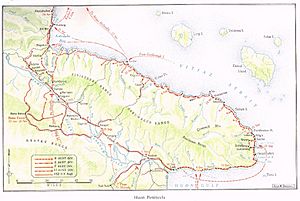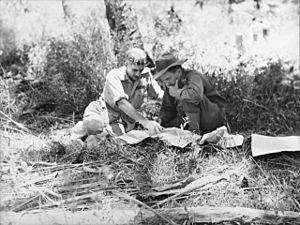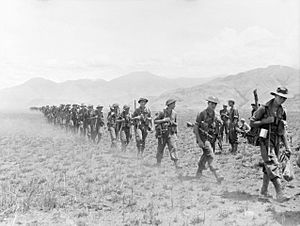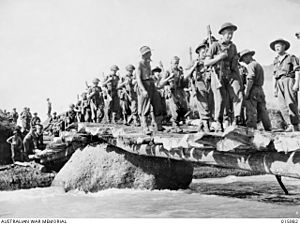Battle of Dumpu facts for kids
Quick facts for kids Battle of Dumpu |
|||||||
|---|---|---|---|---|---|---|---|
| Part of the Markham, Ramu and Finisterre campaigns, World War II | |||||||
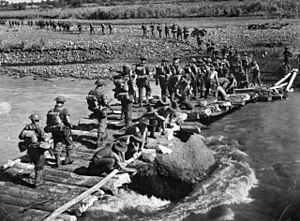 Australian troops cross a bridge over the 19-kilometre-per-hour (10 kn) Gusap River on 25 October 1943 |
|||||||
|
|||||||
| Belligerents | |||||||
| Commanders and leaders | |||||||
| Units involved | |||||||
| 21st Brigade | 78th Infantry Regiment | ||||||
| Casualties and losses | |||||||
| 5 dead 8 wounded 119 sick |
unknown | ||||||
The Battle of Dumpu was a fight between Australian and Japanese forces. It happened in New Guinea during World War II. This battle was part of the larger Markham, Ramu and Finisterre campaigns.
After an earlier victory at Kaiapit, Australian soldiers moved towards Dumpu. This advance was led by Ivan Dougherty's 21st Infantry Brigade. They were part of the 7th Division.
The Japanese forces were led by Major General Masutaro Nakai. His group was called the Nakai Detachment. It included soldiers from the 78th Infantry Regiment. There were some small fights, but the Australians kept moving forward. They captured Dumpu as planned.
During this time, Australian and American troops in the Ramu Valley got their supplies by air. Taking control of the Ramu Valley helped create a new airbase at Gusap.
Contents
Why the Battle Happened
New Guinea's Geography
The Markham Valley is a wide, flat area in New Guinea. It stretches for about 600 kilometres (370 mi). This valley is important because it's flat enough for airstrips. Many small rivers flow through it. The area around the middle of the valley has no forests. This made it easier for vehicles to pass. The Finisterre Ranges, a rugged mountain chain, lay between the Ramu Valley and Madang.
The Military Situation
After capturing Lae in September 1943, the 7th Division had a new mission. Their job was to protect the area around Nadzab. This would allow new airfields to be built there. Airfields were also needed near Goroka and Bena Bena.
At the Battle of Kaiapit, Australian soldiers won a big victory. They defeated a larger Japanese force. After this, Major General George Alan Vasey decided to push forward. He wanted to advance through the Markham Valley to the Ramu Valley. His goal was to reach Dumpu.
Australian spies knew that the Japanese forces were from the 78th Infantry Regiment. This group was called the Nakai Detachment. The Japanese, however, did not know they were fighting the Australian 7th Division.
Brigadier Ivan Dougherty led the 21st Infantry Brigade. He had several battalions under his command. Dougherty believed the Japanese could not support a large force in the area. He was told to reach Dumpu by October 4. After that date, air support would not be available.
The Japanese commander, Lieutenant General Hatazō Adachi, changed his plans. He had wanted his 51st Division to retreat through Kaiapit. But the Australians had blocked that path. So, the 51st Division had to retreat over difficult mountains. This meant the Nakai Detachment didn't need to cover their retreat. On September 23, Adachi ordered Nakai to pull back to Dumpu.
The Battle Begins
Fighting at Sagerak
On September 22, the 2/16th Infantry Battalion arrived at Kaiapit. They immediately set out to find the Japanese. One patrol saw three Japanese soldiers who ran away. The Australians crossed the Umi River, which was wide and fast-flowing. They headed towards Sagerak.
The 2/27th Infantry Battalion arrived at Kaiapit on September 23. They flew in on American C-47 transport planes. These planes were protected by fighter aircraft. The 2/27th took over defending Kaiapit.
The 2/16th Battalion used ropes to cross the Umi River. It took them many hours to get everyone across. On the other side, they met Japanese units. One Australian platoon came under machine gun fire. They used mortars to drive the Japanese away. By the afternoon, the leading platoon was overlooking Sagerak. Their leader was wounded by a sniper. The Australians decided to attack Sagerak the next day.
Later that night, the 2/16th was ordered to pull back. They had to cross the Umi River again, this time in the dark. One platoon was left behind. The next morning, they entered Sagerak and found it empty. About 16 Japanese soldiers had fled. An American engineer quickly set up a landing strip nearby.
General Vasey flew to Kaiapit to talk to Dougherty. Vasey thought the Japanese would attack Kaiapit. He wanted to wait and reinforce Kaiapit. Dougherty disagreed about the Japanese plans.
Advancing to Gusap
The 2/14th Infantry Battalion arrived at Kaiapit on September 25. Other Australian units arrived later. Air Force rules limited landings at Kaiapit. This was to save fighter planes. Vasey met with other top generals. He was told that building roads and fighting at Finschhafen were more important. His 18th Infantry Brigade would not be flown in.
More and more, it seemed the Japanese were retreating. On September 26, a patrol reported that Rumu was empty. The next day, another patrol found Narawapum deserted. That evening, Vasey told Dougherty to advance quickly to Marawasa.
The 21st Infantry Brigade set out. They had jeeps to carry supplies and equipment. On September 28, two companies of the 2/16th crossed the Umi River. The rest of the brigade followed using rubber rafts. Jeeps and light guns were pulled across. Supplies were moved to a storage area at Sagarak.
The track became difficult to pass. So, engineers had to improve it. The airstrip at Sagerak was used to fly in more jeeps and supplies. Vasey flew in and gave new orders to advance to Gusap. By this time, Vasey knew that most of the Japanese 20th Division was not in the area. Only the 78th Infantry Regiment was left to fight them.
Australian commando units were ahead of the main advance. On September 28, a patrol ambushed about 60 Japanese soldiers. They caused heavy losses to the Japanese.
The Australian soldiers advanced very quickly. On October 1, they moved so fast that supplies had to be dropped by air. But because of poor light, only half the supplies were found. The next day, they reached where the Ramu and Gusap Rivers meet.
Reaching Dumpu
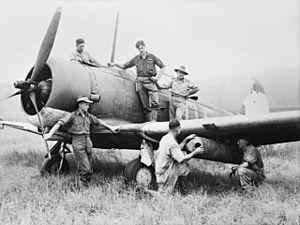
Dougherty let his men rest on October 3. They relaxed and swam in the rivers. But patrols were still sent out. One patrol was ambushed near Namaput village. One Australian soldier was killed. The patrol attacked the village and killed seven Japanese. Three Australians were wounded, and one later died.
The break allowed supplies and support units to catch up. A road had to be built to cross a stream. Then, a bypass was made because the road was impassable. This allowed them to move to an area near Arafagan Creek. The 2/27th Battalion built an airstrip there. Supplies were dropped by air on October 2.
The 21st Infantry Brigade moved out again on October 4. The 2/14th Battalion headed for Wampun. The 2/16th advanced on Dumpu. They crossed the Gusap River on a bridge built the day before.
The 2/14th reached Wampun, which was empty. Their commander, Lieutenant Colonel Ralph Honner, found that his native porters had no water. He went with a small group to find water. They found a banana plantation and thought it was their own troops. But they were fired upon, and Honner and another soldier were wounded. Honner managed to hide in tall grass. Japanese patrols searched for them and wounded Honner again.
Help arrived, and Honner was carried back. He was flown out the next day. Seven Australians were wounded in this fight. Twenty-six Japanese soldiers were killed. Water was found in the area.
Meanwhile, the 2/16th Infantry Battalion crossed the Surinam River. A patrol scouted towards Dumpu. They reported that it was still occupied. But when the main group attacked, there was no opposition. They found food, clothing, and ammunition. They also found signs that Japanese soldiers had been sick. The 2/16th soldiers ate Japanese rice and canned fish for dinner.
What Happened Next
The 21st Infantry Brigade reached Dumpu on time. The Japanese had not stopped their advance. Japanese plans to capture Bena Bena were cancelled. An airstrip was built at Dumpu. This airstrip became very important for supplying later battles.
Between September 15 and October 5, the 21st Infantry Brigade had 5 soldiers killed and 8 wounded. Many more soldiers got sick. Thirty-four had malaria, and 85 had other fevers like scrub typhus. By November 1, many more soldiers were evacuated due to illness.
Engineers decided to build a large airbase near the Ramu and Gusap Rivers. This base was called Gusap. American engineer battalions were flown in to build it. They had special equipment that could be carried by air. Most of their equipment was flown in by C-47 planes.
The engineers first tried to improve an existing airstrip. But it wasn't good enough for many planes. So, they chose a new site nearby. This new site was perfect for more airstrips. An all-weather airstrip was finished by January 1944.
American fighter squadrons moved to Gusap. They flew P-47s and P-40s. Bombardment groups also joined them. The base at Gusap was very valuable. It helped destroy many Japanese planes, equipment, and soldiers.


